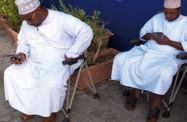With a reduction in mobile tariffs forthcoming, Omani telecoms companies are looking for new ways to attract customers by offering more advanced services at lower rates.
The Ministerial Committee of the GCC Council announced in early February that tariffs on calls made to GCC countries while roaming in the region would be reduced, meaning that mobile operators across the region are now facing price caps for roaming rates. For example, rates for a call from an Omani phone placed outside of Oman but inside the GCC country being visited would be capped at OR0.106 ($0.27) per minute, while rates for a call made to any GCC country while roaming would be capped at OR0.255($0.66).
While global ratings agency Moody’s has expressed concern that the reduced rates could lead to lower revenues, local mobile providers have been quick to refute the prediction. Amer Al Rawas, the CEO of the Oman Telecommunications Company (Omantel), told local media that companies that formerly had much higher roaming rates would be the ones to suffer from the new legislation. “Our rates are closer to GCC rates, so we will be the least affected,” he said.
Local mobile provider Nawras has also said the changes will not affect the firm’s offerings. The company’s SmartRoamer rates, which have been in effect since 2009, were already as low as OR0.099 ($0.25) per minute when calling specific operators within the GCC country visited and OR0.199 ($0.51) per minute when calling other GCC countries while roaming within the region.
Indeed, providers are addressing potential lower revenues with the introduction of new services. Omantel launched a number of new offerings in February at an event hosted by Muscat-based mobile services company Infocomm. These included iMass MMS, which is specifically geared toward businesses in the Sultanate. The iMass service enables companies to include images and audio in their text message marketing campaigns.
Also unveiled was a service that allows businesses registered with Omantel to target potential customers based on their current location. Particularly with the increasing popularity of smartphones, location-based services have become a useful tool for both individuals and companies around the globe. A smartphone user might, for instance, use a location-based service to find a recommendation for a restaurant or store in his or her immediate area, to “check in” to a location via a social network, or to map the way to his or her destination. Companies can use such services to determine a customer’s location and send that person more personally relevant advertisements.
Omantel also announced in February that it has plans to roll out 4G services. No time frame has yet been released for the introduction of the service, but according to Al Rawas, a tender has been floated for the implementation and provision of the necessary technology. The use of 4G will allow for broadband delivery at higher speeds, though it will be introduced in phases, starting first with internet data transmission and then moving to mobile voice services.
Al Rawas added that delays in the implementation of 3.5G technology, which has not yet been fully introduced, were largely due to inadequate allocation of spectrum for the service – an issue the company is working to address with the help of the Telecommunications Regulatory Authority (TRA).
“We have been granted 2.1 MHz, which is high frequency but with a shorter range than low frequency spectrum,” he said at the company’s annual Media Day event in mid-February. “We are working with the TRA to obtain lower frequencies, and this is related to 3G… high frequency spectrum does not help at all because of distances between homes.”
Nawras also announced plans to focus on improving its mobile broadband services, Reuters reported at the end of January. The company experienced a 5% decrease in net profit and mobile and fixed subscribers fell from 2.03m at the end of 2010 to 1.96m at the end of 2011. The international news agency reported that this was “due to regulatory rule changes concerning the counting of prepaid mobile customer base, as well as the reduction in the permissible number of SIM cards one person may hold”.
However, the company sees significant opportunity for growth in the mobile broadband market. In 2011, 25% of Nawras subscribers used mobile broadband services regularly and a further 25% used them on occasion. The company is now aiming to convert more of its prepaid customers to post-paid contracts that include package deals.
In spite of the potential losses due to lower roaming charges, Omani mobile providers have mapped out strategies that will keep customers interested in their products. Indeed, given the increasing rates of smartphone and mobile data use in the country, they have a wide range in which to expand their services and customer bases.

